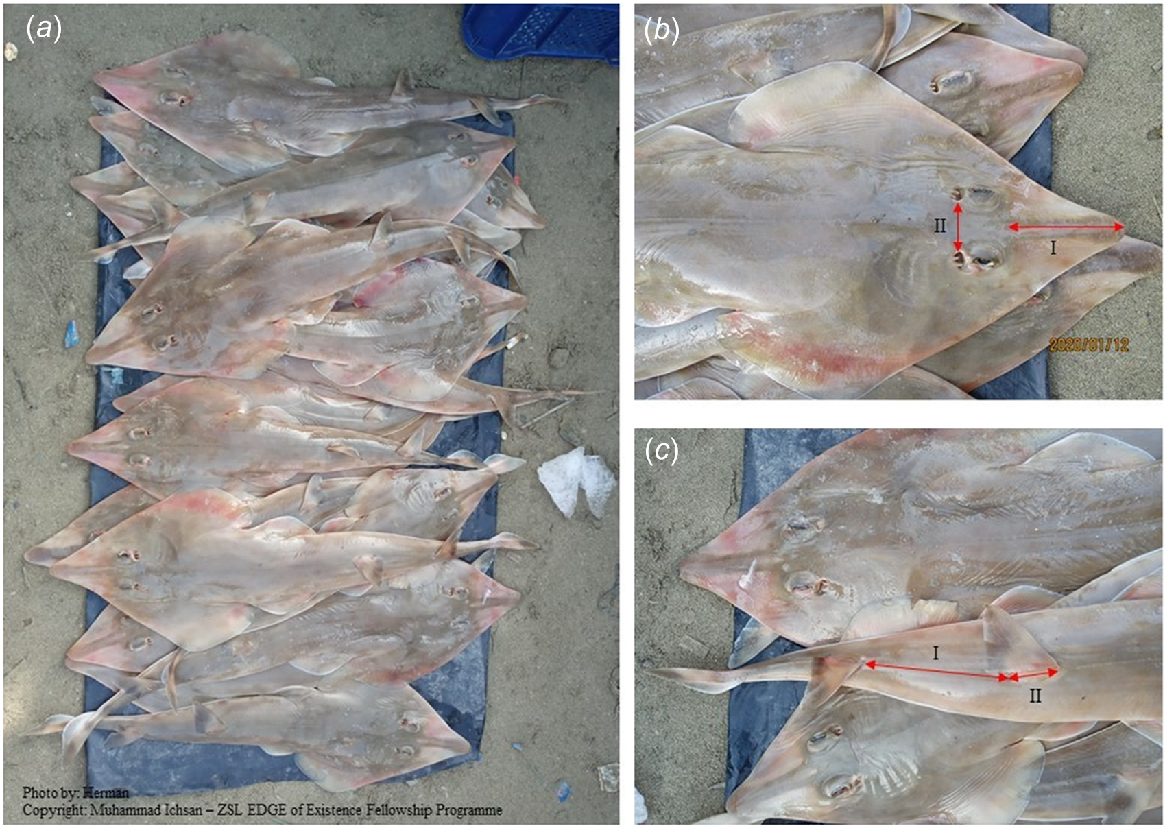New preliminary records of the Ranong guitarfish (Rhinobatos ranongensis Last, Séret & Naylor, 2019) in Southwest Aceh, Indonesia
Muhammad Ichsan A B C * , Niomi Pridina C and
A B C * , Niomi Pridina C and A
B
C
D
Keywords: Batoidea, elasmobranch, Indonesia, Ranong guitarfish, Rhinobatos ranongensis, rays, Southwest Aceh.
In Indonesia, guitarfish are generally caught both as bycatch and target; however, due to a lack of monitoring and identification issues, there is limited species-specific information available for this group of rays that could be used to assess their population (Yuwandana et al. 2020).
We documented elasmobranch catches in data-poor fisheries in Southwest Aceh between 2019 and 2020. In Aceh, rhino rays are caught for their fins and meat, which are utilised for international fin trade and for domestic consumption respectively. We recorded 23 Ranong guitarfish (Rhinobatos ranongensis) caught on a small boat trip on 12 January 2020 using a fixed net 6 kms from Ujong Serangga fishing port, Southwest Aceh.
We refer to the key description in Last et al. 2019 (Fig. 1) for identification. We took documentation of the catches before they sold. We recorded nine male individuals and 14 female individuals. Not all specimens are measured and the measured specimens (N = 7) range between 72 and 87 cm total length.
Ranong guitarfish (Rhinobatos ranongensis) landed in Southwest Aceh. (a) Plain colouration in dorsal surface that differentiates R. ranongensis from four other similar species, (b) elongated snout, shown as I (b) approximately three times interspiracular distance length, shown as II, (c) interdorsal distance length, shown as I, (c) about three times first dorsal fin base length, shown as II (Last et al. 2019). (Photo credit by Herman).

Currently, there is very limited to no species-specific information regarding this species’ reproduction. Based on the previous study, the maximum size is at least 64.5 cm total length (Psomadakis et al. 2019).
There are 20 recorded guitarfish (Genus Rhinobatos) species and so far, three of them have been recorded in Indonesia, namely: Jimbaran shovelnose ray (Rhinobatos jimbaranensis), Indonesian shovelnose ray (Rhinobatos pengali) and Shaw’s shovelnose guitarfish (Rhinobatos thouiniana). Ranong guitarfish (R. ranongensis) is listed as Vulnerable by the IUCN Red List and found in the Eastern Indian Ocean, with the only recorded samples coming from the Andaman Sea, Myanmar, and western Thailand. This makes the specimens landed in Southwest Aceh the first preliminary records of the species in Indonesia. However, the sizes recorded are much larger than those previously recorded for the species (Last et al. 2019), and given the morphological plasticity of these species and the taxonomic complexity of the genus, these records should be considered as preliminary records that require verification through further examination of genetics and life history characteristics. Confirmation of the species’ identity should be prioritised, given the high level of conservation concern for this group of batoids.
Data availability
The data that support this study will be shared upon reasonable request to the corresponding author.
Declaration of funding
This research was funded by Fondation Segre’ via ZSL EDGE of Existence Fellowship.
Acknowledgements
Authors thank all the fishers and people who work at the Ujong Serangga and Lhok Pawoh landing sites. Authors also thank the Fondation Segre’ and ZSL EDGE of Existence programme for the fellowship, Wildlife Conservation Society – Indonesia Program, and Aceh Government for their support during this study. For species visual species identification, we thank Peter Kyne (Charles Darwin University) and Peter Last (Commonwealth Scientific and Industrial Research Organisation).
References
Last PR, Séret B, Naylor GJP (2019) Description of Rhinobatos ranongensis sp. nov. (Rhinopristiformes: Rhinobatidae) from the Andaman Sea and Bay of Bengal with a review of its northern Indian Ocean congeners. Zootaxa 4576, 257-287.
| Crossref | Google Scholar |
Yuwandana DP, Agustina S, Haqqi MB, Simeon BM (2020) Studi Awal Perikanan Pari Kekeh (Rhynchobatus sp.) dan Pari Kikir (Glaucostegus sp.) di Perairan Utara Jawa Tengah. Jurnal Akuatika Indonesia 5, 1.
| Crossref | Google Scholar |


